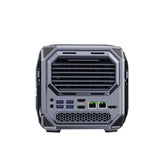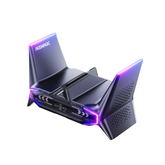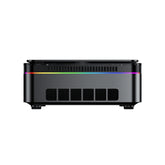Understanding LAN Ports & Ethernet Ports: How They Differ from WAN Ports

What is a LAN Port?
A LAN port, short for Local Area Network port, is a crucial interface found on various electronic devices that facilitates wired network connections. Commonly referred to as an Ethernet port or RJ45 port, a LAN port allows devices such as computers, servers, routers, switches, gaming pc, and smart TVs to connect to a local network using an Ethernet cable. This connection enables high-speed data transmission, ensuring reliable and stable communication between connected devices within a confined geographical area, such as a home, office, or data center.

The primary functionality of a LAN port is to facilitate stable and high-speed data transmission between connected devices within a limited geographical area, such as a home, office, or campus. Unlike wireless connections, LAN ports provide a consistent and secure link, minimizing interference and latency. This reliability is crucial for tasks that demand high bandwidth and uninterrupted connectivity, such as streaming high-definition videos, online gaming, and large file transfers.
The functionality of a LAN port extends beyond mere connectivity. Modern LAN ports support advanced networking features such as auto-negotiation, which allows connected devices to automatically determine the optimal connection speed and duplex mode, enhancing network efficiency and performance. Moreover, having multiple LAN ports on a single device can enable network redundancy and load balancing, ensuring uninterrupted connectivity and improved data handling capabilities.
What does LAN stand for?
LAN stands for Local Area Network, which refers to a network that connects devices within a confined geographical area, such as a home, school, or office building. Unlike Wide Area Networks (WANs) and Metropolitan Area Networks (MANs) that cover larger distances, a LAN enables efficient communication and resource sharing among closely situated devices. The term "LAN port," also known as an "Ethernet port" or "RJ45 port," describes the sockets found on computers, mini pcs, servers, modems, routers, and other network devices that facilitate these wired connections, ensuring seamless and reliable network performance.
How does a LAN port work?
A LAN port serves as the critical interface that enables devices to connect to a Local Area Network (LAN) through wired Ethernet connections. Physically, a LAN port is typically an RJ45 connector, which supports eight metallic pins arranged in a single row. These pins correspond to the individual wires within an Ethernet cable, facilitating the transmission and reception of data between connected devices such as computers, servers, routers, and switches. When an Ethernet cable is plugged into a LAN port, it establishes a stable and high-speed connection, allowing for reliable data exchange within the network.
Once connected, the LAN port operates by utilizing the Ethernet protocol, which governs how data packets are formatted, transmitted, and received across the network. This protocol ensures that data is accurately delivered from one device to another by managing error detection and correction, data framing, and flow control. The Ethernet cable category (e.g., Cat 5e, Cat 6, Cat 6a) plays a significant role in determining the maximum data transfer rates and bandwidth capabilities of the connection. For instance, Cat 6a cables support transfer rates up to 10 Gbps and higher bandwidths, making them suitable for demanding applications that require rapid and efficient data communication.
LAN Port Functions
LAN ports facilitate the physical connection of various devices within a Local Area Network (LAN). This includes computers, servers, printers, gaming consoles, and network switches. By using Ethernet cables, these devices can effectively communicate with each other. Once devices are connected through LAN ports, they can transmit data to and from each other. This encompasses sharing files, accessing shared resources (like printers or NAS), and communicating over local applications. The data transmission occurs at high speeds, depending on the capabilities of the Ethernet cables and the LAN port specifications. LAN ports serve as gateways to broader network functionalities. Through a connection to a router or modem, they allow devices to access the internet, enabling online activities like browsing, streaming, and gaming. This role is crucial in both home and business environments, where reliable internet access is essential for operation.
What does a LAN port look like?

A LAN port, often referred to as an Ethernet port or RJ45 port, is easily recognizable by its distinct appearance. It is typically about the size of a thumb and features a rectangular shape with a slightly beveled top. The port contains eight small metallic pins arranged in a single row, which correspond to the individual wires within an Ethernet cable. Unlike the narrower traditional telephone jacks, LAN ports are wider to accommodate these additional connections, ensuring robust and reliable data transmission. On the Ethernet cable itself, the connector—the RJ45 plug—is larger than a standard phone plug and has a small, transparent plastic tab on top. This tab locks the cable into the port, securing the connection and preventing accidental disconnections.
You will commonly find LAN ports on the back panels of desktop computers, servers, routers, network switches, and other networking equipment. In some devices, especially those designed for easy access, LAN ports may also be located on the sides or front panels. The combination of the port's size, the arrangement of the pins, and the distinctive RJ45 connector makes LAN ports easily identifiable among the various interfaces on electronic devices.
Where are LAN ports located?
LAN ports are commonly situated on the back panels of desktop computers, servers, routers, and network switches to facilitate organized cable management. Additionally, some devices like laptops, gaming consoles, and smart TVs may feature LAN ports on the sides or front for easier access. In specialized equipment, such as edge servers, LAN ports might be positioned at the front of the chassis to accommodate limited space and enhance accessibility. Overall, the placement of LAN ports is designed to balance convenience and efficient network connectivity across various types of electronic devices.
What is a LAN cable?

A LAN cable, commonly referred to as an Ethernet cable, is a type of networking cable used to connect devices within a Local Area Network (LAN). These cables are essential for establishing wired connections between computers, servers, routers, switches, gaming consoles, and other network-enabled devices, ensuring reliable and high-speed data transmission. Unlike wireless connections, LAN cables provide a stable and secure link, minimizing interference and latency, which is particularly important in environments that demand consistent network performance, such as offices, data centers, and gaming setups.
Ethernet cables come in various categories, each designed to support different levels of performance in terms of data transfer rates and bandwidth. The most prevalent categories include Cat5e, Cat6, Cat6a, and Cat7. For instance, Cat5e cables can handle speeds up to 1 Gigabit per second (Gbps) with a bandwidth of 100 MHz, making them suitable for everyday networking needs. Cat6 cables offer improved performance with the same 1 Gbps speed but increased bandwidth up to 250 MHz, which is beneficial for more demanding applications. For even higher performance requirements, Cat6a and Cat7 cables support speeds up to 10 Gbps and offer higher bandwidths, accommodating the needs of high-definition streaming, large data transfers, and advanced networking setups.
Differences between LAN Port and WAN Port
A LAN port (Local Area Network port) and a WAN port (Wide Area Network port) serve distinct functions within network hardware, each catering to different aspects of network connectivity. Understanding their differences is essential for setting up and managing both home and enterprise networks effectively.

LAN Port vs WAN Port: Function and Purpose
A LAN port is primarily used to connect devices within a local network, such as computers, printers, servers, and switches. These ports facilitate the internal communication and resource sharing within a confined geographical area, like a home, office, or data center. For example, in a typical home router, multiple LAN ports allow various devices to access the local network and share the internet connection provided by the WAN port
In contrast, a WAN port is designed to connect the local network to external networks, most commonly the internet. This port serves as the gateway between the internal LAN and the broader Wide Area Network, enabling devices within the LAN to communicate with external servers, websites, and remote networks. Essentially, while LAN ports handle internal traffic, the WAN port manages outbound and inbound traffic to and from the internet.
LAN Port vs WAN Port:Physical Appearance and Placement
Physically, LAN and WAN ports often look similar, typically featuring the standard RJ45 connector used for Ethernet cables. However, their placement on networking devices like routers and switches can help distinguish their roles. On a router, LAN ports are usually grouped together on one side or back panel, clearly labeled to indicate their use for local device connections. The WAN port, often labeled as "Internet" or "WAN," is typically separated and may be positioned distinctly to signify its role in connecting to the external network.
LAN Port vs WAN Port:Network Configuration and Management
From a configuration standpoint, LAN ports are configured to handle multiple devices within the same network segment, often supporting features like DHCP (Dynamic Host Configuration Protocol) to assign IP addresses automatically to connected devices. This setup ensures seamless communication and resource sharing within the local network.
From a configuration standpoint, LAN ports are configured to handle multiple devices within the same network segment, often supporting features like DHCP (Dynamic Host Configuration Protocol) to assign IP addresses automatically to connected devices. This setup ensures seamless communication and resource sharing within the local network.
LAN Port vs WAN Port:Performance and Security Considerations
Performance-wise, both LAN and WAN ports support high-speed data transfer, but their roles in the network dictate different performance priorities. LAN ports focus on ensuring fast and reliable internal communication, supporting activities like file sharing, streaming, and local gaming. WAN ports prioritize stable and efficient internet connectivity, handling tasks like web browsing, cloud access, and online communication.
From a security perspective, LAN ports are confined within the local network, allowing for controlled access and internal security measures. WAN ports, being exposed to the vast and variable internet, require robust security protocols, such as firewalls and encryption, to protect the internal network from external threats.
Read More
HDMI vs. Micro HDMI vs. Mini HDMI: The Ultimate Comparison Guide
Let's talk about DisplayPort 1.2: everything you need to know.
Difference Between USB A vs USB C & Which One is Better
HDMI 1.4 vs 2.0: What's the Difference and Which One Should You Choose?
Frequently Asked Questions (FAQs)
What is the difference between a LAN port and a WAN port?
A LAN port (Local Area Network port) is designed to connect devices within your local network, such as computers, printers, and switches, enabling them to communicate and share resources. In contrast, a WAN port (Wide Area Network port) connects your local network to external networks, like the internet. Typically found on routers, the WAN port links to your modem, allowing all devices connected via LAN ports to access the internet.
Can I use an enet port for internet connectivity?
Yes, you can use an enet port for internet connectivity. The term "enet port" is a shorthand for "Ethernet port," which serves the same function as a LAN port. By connecting your device's enet port to a router or modem using an Ethernet cable, you establish a wired connection that provides reliable and high-speed internet access.
What cable type should I use for my Ethernet port?
The type of Ethernet cable you should use depends on your network's speed requirements and the environment. Cat5e cables support speeds up to 1 Gbps and are suitable for most home and office networks. Cat6 and Cat6a cables offer higher bandwidth and can handle speeds up to 10 Gbps, making them ideal for environments that demand faster data transfer and reduced interference. For the best performance, especially in high-demand settings, opting for Cat6a or higher is recommended.
How do I know if my device supports gigabit Ethernet?
To determine if your device supports gigabit Ethernet, check the device's specifications in the user manual or on the manufacturer's website. Look for terms like "Gigabit Ethernet," "1000BASE-T," or "1 Gbps" in the networking section. Additionally, inspect the Ethernet port itself; gigabit ports are often labeled with indicators such as "Gig," "1000," or may have different color coding to distinguish them from slower ports. You can also verify the connection speed through your device's network settings when connected.
Is LAN the same as Ethernet?
While LAN (Local Area Network) and Ethernet are closely related, they are not identical. LAN refers to a network that connects devices within a limited geographical area, such as a home or office. Ethernet, on the other hand, is a family of networking technologies used to create wired connections within a LAN. In essence, Ethernet is a protocol that facilitates communication between devices on a LAN, making them interdependent but distinct concepts.
Do I plug Ethernet into WAN or LAN?
Generally, you plug Ethernet cables into LAN ports when connecting devices within your local network, such as computers, printers, or switches. The WAN port is specifically used to connect your router to an external network, typically linking to a modem for internet access. Therefore, for most device connections within your home or office, you should use the LAN ports, reserving the WAN port for your router's connection to the internet.
Is LAN better than WiFi?
Wired LAN connections often outperform WiFi in several key areas. They provide more reliable and stable connections, higher data transfer speeds, and enhanced security compared to wireless networks. Wired connections are less susceptible to interference from other devices and physical obstacles, ensuring consistent performance. However, WiFi offers greater flexibility and mobility, which can be advantageous in environments where running cables is impractical. The choice between LAN and WiFi ultimately depends on your specific needs for speed, reliability, and convenience.
Is Wi-Fi a LAN or WAN?
Wi-Fi is LAN, Wi-Fi is a method of implementing a Local Area Network (LAN). As a wireless LAN technology, Wi-Fi differs from traditional wired connections by allowing devices to communicate without the need for physical cables. It enables devices to connect and communicate through wireless signals, providing a flexible and cable-free networking solution.








Leave a comment
Please note, comments need to be approved before they are published.